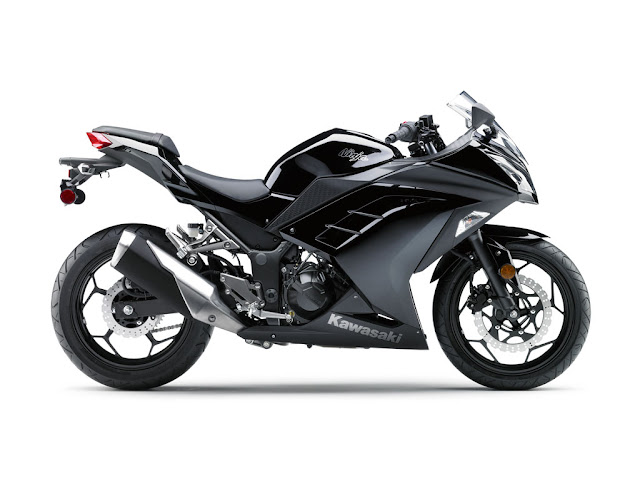The littlest Ninja 2013 Kawasaki Ninja 300
After finally experiencing competition in the beginner bike market from Honda’s CBR250R, the Ninja 300 looks to regain its stranglehold of the class. The new 300 takes the 250cc, liquid-cooled, parallel-Twin mill of the old Ninjette and pumps it to 296cc by virtue of a longer stroke (49.0 mm vs. 41.2 mm). Bore dimension remains the same at 62.0 mm.
Already a feature in European Ninja 250s, digital fuel injection is now part of the package for American riders. This should cure the EPA-mandated lean jetting used in the old 250’s carburetors, upping performance and mileage while helping it meet ever-increasing emissions requirements and making cold start-ups a breeze. Dual 32mm throttle bodies feed air and fuel to each cylinder. Engine internals get a makeover as well, with larger intake ports and intake valves increasing in size 1mm to 23.6mm.
The undersides of the pistons are revised to more efficiently route oil across their surface. Piston pins are lightened to reduce reciprocating weight, while new, shorter connecting rods offset the longer crank throws, leaving deck height the same as before. Sleeveless “open-deck” aluminum cylinders shave 800 grams and feature a friction-reducing plating. Interestingly, compression ratio is reduced one point, from 11.6:1 to 10.6:1, to allow the use of regular-unleaded gasoline. Maintenance is also simplified with the adoption of an easy-access, spin-on oil filter.
All six gears are beefed up to cope with the added power. Kawasaki’s positive neutral finder also sees its way onto the Ninja 300, making it a snap to find neutral while stopped. A new clutch now sees “assist” and slipper functions: the former helping to reduce lever pull by up to 25%; the latter helping keep the rear wheel in line when performing aggressive or sloppy downshifts.
This new engine is cradled in a frame utilizing high-tensile steel main tubes claimed to be 150% more rigid than before. Revised tube shapes and additional gusseting provide additional longitudinal stiffness for better feel while riding hard. Softer spring rates at both ends of the suspension complement the stiffer chassis, though neither end is adjustable, save for rear preload.
New 10-spoke wheels give a more racer-like appearance, while rear wheel width is upped half an inch to 4.0 inches, allowing a 140-section rear tire to be fitted. Mated to each wheel are single petal-type discs, 290mm front, 220mm rear, paired with twin-piston calipers. According to Kawasaki, ABS models receive the world’s smallest motorcycle ABS unit. Made by Nissin, the entire unit adds less than 4.5 pounds to the weight of the bike.
Styling cues gets inspiration from the flagship ZX-10R, with the split headlight, minimalist tail section and separated seats lending to a more aggressive look. At a claimed curb weight of 379.3 pounds, the non-ABS model gains only 4.4 pounds over the 250.The Ninja 300’s ergonomics feel very similar to the 250 of yesteryear. Its seating position is neutral thanks to bars mounted above the triple clamp, and footpegs are also placed in a comfortable position. Pricing is yet to be determined as of press time. Look for a full review of the Ninja 300 coming soon, as we’ll be riding this exciting small-bore machine next week.


0 Response to "The littlest Ninja 2013 Kawasaki Ninja 300"
Post a Comment